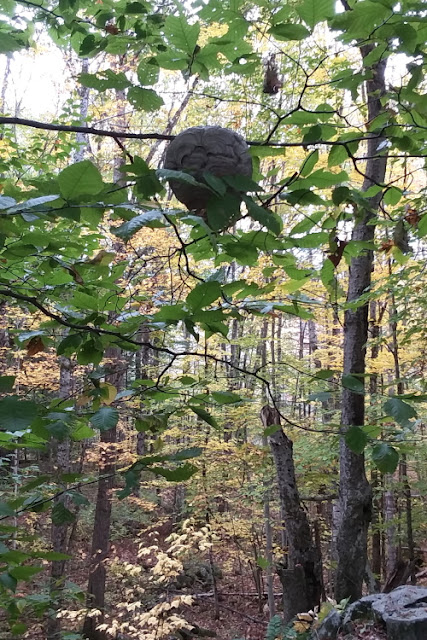The past week provided us both beautiful late summer days and cool, damp October days - I was able to get on the lake on one of the former for a perfectly calm autumn paddle.
Paddling alongside a marshy shoreline I noticed those little brown specimens left carefully on a log, knowing they were from a mammal, and certainly an aquatic one.
A quick check of the nature guide confirmed my first thought: Muskrat. These animals are closely related to beavers in both appearance and behavior, as muskrats also make lodges out of mud and vegetation, but they will also carve dens in the bank of a lake or river. They will even dig a den into the walls of a beaver lodge! They can be distinguished from beavers by their smaller size and the fact that they have a skinny, rat-like tail rather than the broad tail of a beaver. Muskrats eat mostly aquatic vegetation, but will also eat clams, fish, and other small animals. I once saw a muskrat swimming along carrying a freshwater mussel in its mouth.
 |
| Taken in April at 5:30pm, is this a parent bringing dinner home for the kids? |
Muskrats leave their scat on logs and rocks just above the water line, and that larger brown mass is from an older visit to that log.
There were other, prettier sights to see on my trip around Lake Wicwas, including geese, loons, and an eagle.
 |
| I'm guessing this is Harley. |
 |
| A couple of geese keep an eye on me. |
I didn't see the bald eagle until it flew out of tree as I passed under it, but I was able to catch a picture as it flew down the lake.
As soon as it was airborne the loons started hollering. The loon I had passed by earlier, perhaps a quarter mile away, was the first to see it - they are clearly paying attention to the sky. It gave out a loud alarm, and then from far down the other end of the lake a second loon responded as if to say "thanks for the warning, yes I see it coming right towards me." They continued to call back and forth to each for several minutes.
Unlike an event Dave Thorpe witnessed a few days earlier, the eagle flew off over the lake, not bothering either loon. But Dave saw a much more dramatic event, where the eagle dive-bombed one loon, flew back up, and then repeated the attack on a second. In both attacks Dave reported a large splash of water, but he wasn't able to determine if it was the eagle hitting the water or the loon creating a diversion as a means of defense. Either way, it gives me further confidence that our loon chicks are able to defend themselves.
On an earlier hike up to Arbutus Hill I noticed an interesting hole in the ground.
 |
| Not a great picture, but you can see the papery outer layer of a yellow jacket nest. |
It wasn't until I had my face down there that I realized it was a yellow jacket nest that a bear had ripped into to access the eggs, larvae, and any other protein that was present. I'm always amazed at a bear's moxie to go after a large bee's nest - how many angry stinging insects would swarm it, especially its exposed face and eyes? I was happy there was only a stray bee crawling around in the nest, surveying the damage. I didn't stick my hand down there to pull out the leaves that had blown in.
Both of our chicks and one adult continue to linger on the lake, enjoying the end of the fall season as much as I am, while it lasts.












































